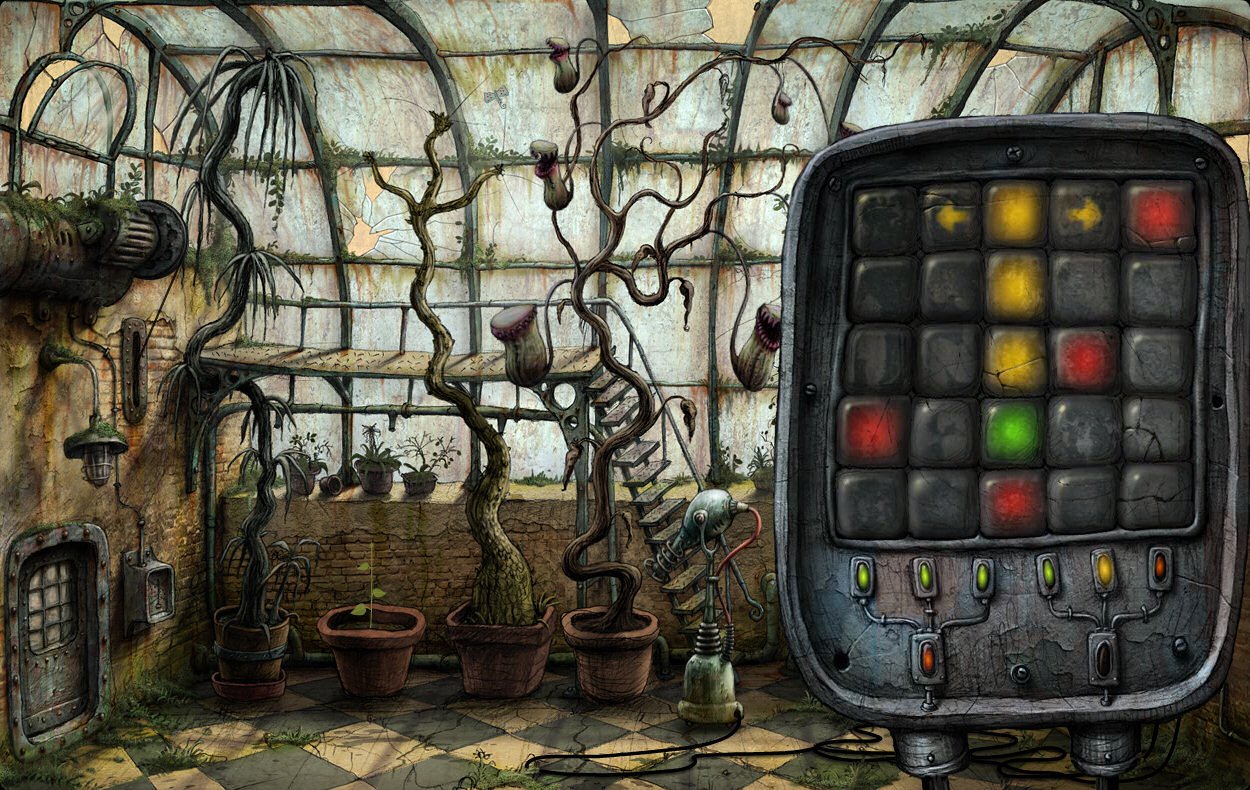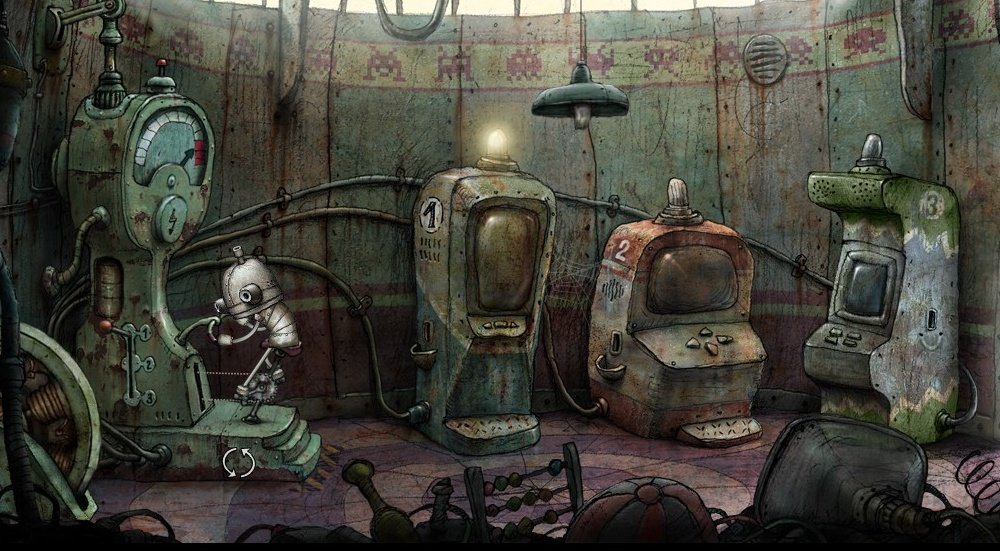Cast your mind back to 2009: the sheer brilliance of Uncharted 2: Among Thieves was helping to establish Naughty Dog as the best developer in the business, whilst Batman: Arkham Asylum proved that licensed games could actually be good, and PS4 and Xbox One were but a glint in the eyes of their creators. 2009 also happened to be the year that Machinarium was first released for PC and Mac. So with the game’s recent release on Vita (the version we’re reviewing here), it’s fair to say that Sony‘s handheld is a little late to the party, but has it been worth the wait? Let’s find out.
Upon its initial release, Machinarium attracted plenty of critical acclaim for its fantastic art direction and stripped-back approach to the classic point ‘n’ click adventure genre. Indeed, this simplicity is very much evident throughout, particularly in the game’s character interaction (there’s no visible/audible dialogue at all) and narrative. The player adopts the role of Josef, a small robot, as he enters into the city of Machinarium in order to save his girlfriend and foil an evil plot to blow up the city’s tower. We get to meet plenty of Josef’s robotic friends and foes along the way too, and developers Amanita Design deserve huge credit for their brilliant character design; imbuing what are effectively just machines with such playful personalities is no easy task, yet it is pulled off with aplomb here. Amanita also totally nail the setting. The eponymous Machinarium is always an interesting place in which to rummage around: an intricately-designed, humanistic world populated entirely by robots, and it is suitably bleak to help portray the general tone of Josef’s dire situation.
Presentation aside, Machinarium is a classic adventure game at heart, with a multitude of item-combining conundrums and environmental puzzles to be solved. And unfortunately, it’s here where the game throws its focus on simplicity out of the window. You see, Machinarium can be about as welcoming and penetrable as Fort Knox when it comes to knowing what it wants you to do to solve a puzzle. You’ll sometimes enter a room and have next to no idea of the convoluted set of actions that you’re meant to complete to progress, or even if you’re in the correct room in the first place. Any adventure game veterans out there will know that these have been issues with the genre ever since its conception. Some developers circumvent this by keeping things logical: allowing you to reach the solution with a bit of common sense and analysis of your surroundings in conjunction with your inventory. Unfortunately, Machinarium mostly falls on the other side of this divide; the side that usually results in you desperately clicking on everything in the environment in the vain hope that something constructive might occur…
Admittedly, the game does feature a mechanic that allows you to see a small pictorial clue that is meant to show what you need to do to get out of the room you’re currently in. However, these are often so basic and patronizingly unhelpful that they might as well just say, “Solve the puzzle to proceed!” That’s it. Well, thanks, but… I ALREADY KNEW THAT!!
The game also features an annoying amount of puzzles that are entirely unrelated to the story. These usually take the form of generic block/bead/switch challenges. For example, one puzzle requires you to move beads around a restricted path to get them in the correct positions, whilst another tasks you with changing lights on a display to make them all turn green. They’re the sorts of puzzles that can’t really be solved with logic, instead demanding endless amounts of trial and error, as you make mistake after infuriating mistake until you finally stumble across the correct combination. It also doesn’t help that there are no instructions at all for each puzzle, so you often won’t be sure if what you’re trying is actually the right thing to do, or whether you’re unknowingly barking up the completely wrong tree. Ultimately, Machinarium‘s head-scratchers just aren’t that enjoyable, and in a game that relies so heavily on puzzles, that’s a pretty big problem.
Amanita seem to have recognized that the average gamer would grow tired of trying to solve Machinarium‘s abundance of brain-teasers, because the game includes a system in which you can complete a level of an old-school, side-scrolling shooter in order to unlock the solution to the current/next puzzle. However, this mechanic is heavily flawed for several reasons. Firstly, the mini game isn’t actually any fun whatsoever, and it can last a few minutes at a time, thus slowing your progress even more. The bigger issue, however, is that once you do complete the mini game, you’re presented with a set of pictures that depict the entire solution to the puzzle in question. Surely the more sensible option would have been to give players the option to have a couple of small, subtle hints which gently nudge them in the right direction, rather than just blurt it all out in one go? Even so, most gamers will inevitably reach the stage where they simply want the current puzzle to be over, but will groan at the prospect of having to complete the mini game for the umpteenth time. And when you do hit that wall, I defy you not to reach for your nearest PC/tablet/mobile device and input the words “Machinarium” and “walkthrough” into your search engine of choice.
That isn’t to say that Machinarium is a complete failure, though; far from it. It has charm and personality flowing from every pore, and there are some genuinely lovely and smile-inducing moments. When you’re outside of the puzzles (which, unfortunately, isn’t often enough) the world is a joy to explore. There’s plenty of entertaining locales on offer, from a bar (where the robotic drink of choice is, of course, a pint of oil) to a prison, and there’s even time for a trip to the local arcade to play some cool retro games.
As mentioned previously, Machinarium started life as a PC/Mac title, so there may have been some doubts as to the success of the game’s conversion to Vita. Well, in general, Amanita have done a top-notch job in this department. Firstly, the game looks fantastic on the OLED screen: everything is pin-sharp and runs as smooth as a knife through warm butter, which really helps to bring the world to life. The touchscreen has also been incorporated to allow you to directly touch the parts of the environment that you want to interact with. This works perfectly fine for the most part, although the touch detection can be a little wonky at times. And it’s because of this that I’d probably recommend playing the PC version instead; using a mouse to control the cursor is just so much more intuitive. But if the Vita is your only option, then by all means, go for it.
At £6.49/$6.99/€5.99, Machinarium is very reasonably priced for what it is. The game can last anything from 5-8 hours, depending on how long you spend stuck on puzzles. Although it must be noted that the single player experience is all that’s on offer here: once you finish the story, you’ve basically seen all the game has to offer. With all of that in mind, it seems fair to say that Amanita have hit the sweet spot with the price.
To sum up my thoughts on Machinarium, I’d say the following: when I first booted up the game, I was fully expecting to love it (I’m generally a big adventure game fan), but upon reaching the game’s conclusion, I let out a sigh of relief and was left with little desire to experience it again. As for whether you’ll feel the same really depends on the kind of gamer you are; if you enjoy slow-paced, cerebral experiences that require a lot of trial and error, then you’ll no doubt extract plenty of enjoyment from Josef’s adventure. However, if you’re prone to having a lack of patience and struggle with occasionally illogical and impenetrable puzzles, then you may wish to steer clear. It’s a real shame, because it is abundantly clear that a lot of love has gone into crafting Machinarium; the game just seems to stumble when it comes to actually offering a fun experience. And as such it really struggles to compete with the giants of the genre, such as the Broken Sword and Monkey Island series. Here’s hoping the oft-rumoured Machinarium 2 rights the wrongs of this original and makes booking a return trip to Amanita‘s robotic world a worthwhile venture.
This review is based upon a downloaded retail copy of Machinarium on PS Vita. The game is also available for PS3, iOS, Android, PC, and Mac. Developed and published by Amanita Design.
- Charming World
- Brilliant Art Direction
- Frustrating Puzzles
- Awful Hints Mechanic





